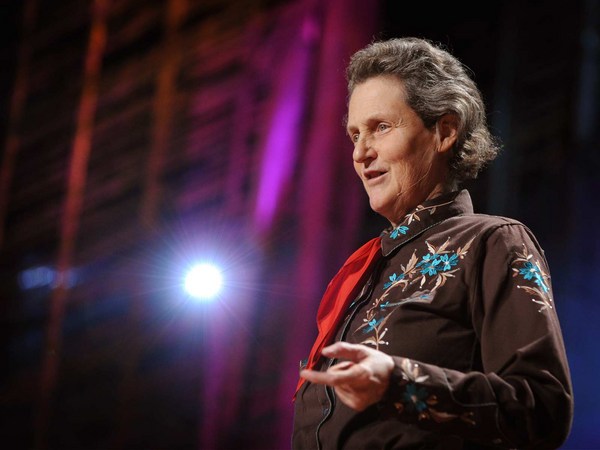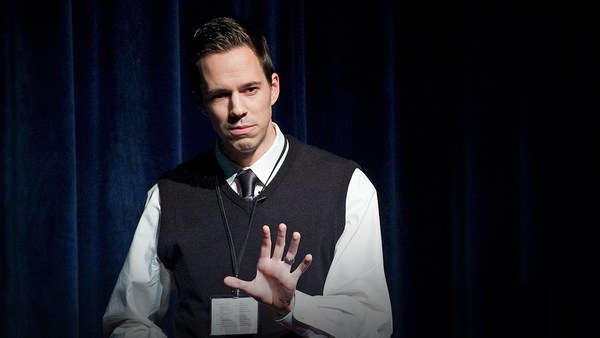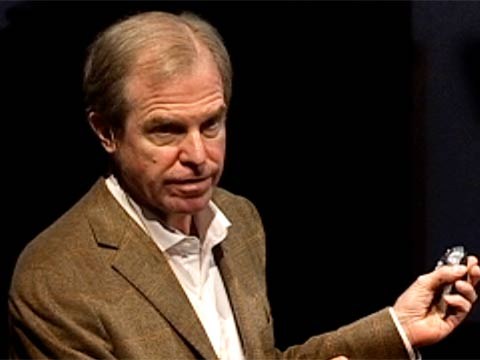Well, it's really great to be here today, but I want to talk about different ways that people think, and one of the first steps is realizing that different kinds of thinking exist. Another thing I want to challenge the educational system with is there were some really great minds in the past, and what would have happened to them if they were in today's educational system? What would have happened to Michelangelo today, Beethoven today? Thomas Edison? A lot of people? What would happen to them? OK, we're all familiar with Michelangelo's art. And there's been a book written about Michelangelo by one of his students. It's been translated into English. And he was a lousy student. He dropped out of school at age 12. That's 6th grade - 6th grade high school dropout. That's Michelangelo. And his father hated art, said that he didn't consider it "learned." He wanted him to grow up and write legal documents. Yuck! (Laughter) Now, fortunately, he was raised in a situation where they had access to stonecutter tools. So he had some exposure to it. All the churches were doing all kinds of art. So he grew up with exposure to it. This brings up another very important thing: how do students get interested in something? They get exposed. I ended up in the cattle industry because I was exposed to it when I was 15 years old. How about Beethoven? He had great accomplishment, but a lot of adversity, and he wrote his greatest works when he was half deaf, and all the way stone-deaf, and he couldn't perform anymore. And we're still playing his music today. In fact, he had a piano company build a special device to go on the piano to help him to hear. And this is a reproduction of the device made by the Orpheus Institute. But he wanted to accomplish things. Okay, this is one of my most important slides: the different kinds of minds. I'm a photorealistic, visual thinker, an object visualizer. And you know what? I can't do algebra! And I'd be screened out of today's educational system. I do talks all over the country on education, I'm talking to high school kids that can't graduate from high school if you can't do algebra. If I'm going to be a chemist, I need algebra, but for a lot of things you don't, and we need visual thinkers. We need visual thinkers to solve problems. Another kind of mind is the mathematical mind, a pattern thinker. They think more mathematically. They don't think in pictures. And then you have the verbal facts people. Now let's look at how the different kinds of minds approach problem-solving. Visual thinkers are bottom-up thinkers. Concepts are learned with specific examples. I've done a lot of work on improving things in the livestock industry. But it was something specific. It wasn't vague and abstract. A lot of verbal thinking on a lot of different issues, it gets very abstract. I've got to have an issue that I can really put my head around, so I can do something about it. But the first step is we've got to realize these different thinkers exist. The skills can complement each other! Think about the iPhone - Steve Jobs was an artist! That's why your phone is easy to use. The mathematicians had to make it actually work. And I've had some brain scans, and I've found out that I've got some big visual thinking circuits! And this shows my lack of working memory. So what am I doing with this piece of paper up here? This is my external working memory. Because I don't have working memory. It's all full of water. In fact, if I was a computer, I've got the Amazon cloud or the Microsoft cloud, the Google cloud, whichever cloud you like the best, for graphics files, huge memory for graphics files. If I can convert it to a graphics file, I remember it. But I'm only a 286, or a one-bar phone, when it comes to working memory. So that's why I have these notes here - because it's my external working memory. Now, how do you figure out in kids what kind of thinker you are? Visual thinkers are good at art, mechanical things. I was good at photography. And this will show up in 2nd or 3rd grade. Mathematical thinkers will be good at math. And one of the big mistakes that's made is they're giving the kids baby math, and so the math ability doesn't get developed. Another thing about some of these kids that are super good at math is they do it in their head. Don't make them verbally show their work. That's not how they think. We've got a big shortage right now of computer coders. Well, maybe computer coding needs to be introduced to third graders. And then there are verbal thinkers, who love history, love facts. Verbal thinkers, I need them to make my things more linear. Many of my books have co-authors, because a visual thinker tends to be scattered, so I need a verbal thinker to make the book more linear. See, that's the different kinds of minds working together. Now I want to talk about the space program. I always loved the space program. It was the greatest achievement of my generation. And there's now people that were mission-critical that are now getting recognized. And I was very emotional to go down and visit the Vehicle Assembly Building. I just loved doing that. There was a guy named Hal who did algebra equations, algebra equations for fun, in a reclusive and messy office. He admitted he didn't do any of the work, but without his equations, the lunar landing would not have worked. He was mission-critical. Katherine Johnson, the mathematician - and she finally got recognized. Her mathematics for calculating orbits was absolutely essential. Now we've got to give some ladies credits here. The Playtex Corporation made the space suit. Four of the finest bra seamstresses sewed it, and their boss was a TV repairman. This was probably not the mathematics department here. But the space suit was super mission-critical. When I went and visited Cape Kennedy two and a half years ago, I found out maybe the right stuff rides to the moon, but the geeks and the misfits and the kids with labels build the stuff. (Laughter) I spent 25 years in construction, and I've worked with skilled trades people that today would be diagnosed as autistic, dyslexic or ADHD. So where's that kid today? Probably playing video games in the basement because nobody thought to let him play with tools when he was little. Also, one of the people that worked on this launchpad had Tourette syndrome. Now, this brings up an important thing about identity. Autism is an important part of who I am, but career comes first. And people ask me all the time, "Was it really hard, as a person with autism, to go into the cattle industry?" Nope, back in the '70s, being a girl was a bigger barrier than autism could ever be! (Laughter) And they really did put bull testicles on my vehicle. That scene happened. And another thing in the movie that's totally true is visual thinking. It shows that accurately. Now, my grandfather was the co-inventor of the autopilot for airplanes, and he worked with another person that probably was autistic, probably a visual thinker, who came up with this idea for three little coils. Then my mathematically-minded grandfather, MIT-trained engineer, did the math for it; the different minds working together. A lot of kids are getting labels - autism, dyslexia, ADHD. I'm worried about them getting screened out. We need their minds. Thomas Edison was labeled as a hyperactive high school dropout. He's got some autistic traits. Jane Goodall only had a two-year secretarial degree when she did her famous work. Would that be possible today? I want to make you think. Steven Spielberg - bullied, dyslexic, rejected from a top film school. One of the things that saved him: he was exposed to movies when he was a kid with a Super-8 movie camera. I got bullied in high school. They called me all kinds of names, like "tape recorder" and "bones." They'd go, "Bones!" as I walked across the parking lot. And the only places I was not bullied was when I was doing a shared interest with a friend of mine - riding horses, some other friends I had with electronics, friends who shared interests. Schools need to be keeping these classes: art, sewing, musical instruments, woodworking, theater, welding, auto shop ... (Cheers) (Applause) creative writing. (Applause) We need to be keeping these classes. They also teach practical problem-solving. A Nobel Prize winner was 50% more likely to have an art-and-crafts hobby compared to just some other scientist. That's another reason. Steve [Jobs], bullied in school. What would happen to him today? Albert Einstein, no speech until age 3. He'd probably be in an autism class today. Where would he go today? I want to have you think about that. And the debate between so-called useless humanities programs, such as calligraphy, should not be ignored. Calligraphy was one of the things that helped Steve Jobs to be a good designer! We've got kids today who don't know how to hook up a garden hose. (Laughter) They've gotten totally away from the world of the practical. I have a livestock handling class, and my students have to do a scale drawing. And we've got some students today who've never used a ruler, never used a ruler to measure anything. Well, I don't know about an electric drill for a kid this little, but we wanted to have kids growing up and doing real things. And I loved this kindergarten: they had five-year-olds making things out of broken computer parts. This is actually an Italian model. They believe in hands-on. We've got a huge shortage today of skilled trades - plumbers, electricians, mechanics, welders ... Computers are not going to replace this! Maybe in the future the computer will diagnose your medical problems, but it won't fix the hospital's air conditioning. Always going to have to have people to fix things. These self-driving cars, they've got a lot of different sensors and complicated stuff on them. I had a chance to visit Apple, and that was super cool, and they need coders, and they need them really badly. And there's a lot of kids out there that are good at math. Somebody needs to introduce them to coding! And when I was a young kid, I used to love to do little projects. That was a little bird kite that I invented, and I had to tinker to make it work. Yeah, we need to get kids doing these things. Now, when you're weird, what you have to do is you have to sell your work. So this is one of my drawings right here, and when I'd show my drawings to people, people were impressed. In fact, this is a drawing that I sold a major meat company to have them have me design stuff for them. I simply showed them my work. Now, why does it say you have to touch to perceive? When our industry went from hand-drafting to computers - this was in the mid '90s - I started noticing very, very strange mistakes on drawings - like the center of a circle was not in the center of the circle. And what I learned was that person had never drawn by hand, and they'd never built anything. And even today, I've got some drawings from a major engineering company that had some concrete work in it with no reinforcing rod. Really? I don't think that's a very good idea. They're not seeing their drawings. When you're weird, you've got to show what you can do. Show your work off. That's what you've got to do. And this is a picture of one my early jobs, and this is the kind of pictures that I would put in my portfolio to show clients. An interview for me was spread the drawings on the table, put the pictures out there, give them my brochure ... That's the replica of one of my systems they built for the HBO movie. And I loved the fact that they put my projects in it. I've also realized that working with building things changes your attitude about how you do stuff. You have to actually get stuff done, and it's something specific that you have to get done. It's not abstract; it's real. And there's my brochure, black and white, because back in the '70s, '80s and '90s, color printing was just too expensive. There was no way I was going to pay for color printing. So I made it really nice in black and white. Now, what are some of the common denominators of some of these kids that are different, of some of these individuals growing up with lots of books and learning? When I was a young kid, my mother always read to me. I had some very good teachers. This is super important. I didn't talk until age 4, so I had a very good speech teacher, and if people talked too fast, I couldn't hear what they said. It was like, "Buh, buh, buh, buh." So my speech teacher would slow down and enunciate the hard consonant words. I had Mrs. Deetch, my 3rd grade teacher ... Mother had a really good sense of how to stretch me. A lot of these kids are getting too overprotected now they have a label. And the problem we've got with autism is it goes all the way from Einstein, or maybe Thomas Edison, to somebody who can't dress themself. We've got the same word! So the verbal thinkers get locked too much into the word! And early exposure to career interests, learning how to work. My mother got me a sewing job when I was 13; I was cleaning horse stalls at 15. Learning how to work: super, super important. Great mentors - I had a wonderful science teacher. He actually was a NASA space scientist, and what he did is he got me interested in studying, because now, education was a pathway to a goal. It wasn't done "just do it for the sake of education." I'm seeing a lot of kids today: they doing super well on their academics, but then when school's over, what's next? Well, this is the reason why they need to learn how to work. I've counseled a lot of students, and said, "If you're in college right now, do career-relative, relevant internships. Go out and try on careers. Find out what you love, but also maybe find out what you hate." It's important to do that. You can't get an internship? I say, "Get on your department's web page, get on the web pages of whole other departments. There's all kinds of interesting stuff going on that you can get involved in, if you just look." And then you discover something, because originally I thought I was going to be an experimental psychologist who studied optical illusions. Well, that wasn't what happened to me. (Laughter) It's just that simple. Also, when you don't have much working memory, learning how to drive is going to take longer. But it's essential, and I can't use this external working memory to learn how to drive. So what you've got to do to solve the problem of multitasking is get out there and practice, practice, practice in totally safe places for a long time. I did 200 miles on dirt roads, and the truck was three on the tree, with a really terrible clutch. (Laughter) And it started out lurching all around the horse pasture. It was just absolutely awful. (Laughter) Well, the thing that's really important is we need all the different kinds of minds, and I'm worried that in some school systems we're screening out some of these kids because they can't do algebra. If you do chemistry, you'll do a lot of things that need algebra, but you don't need it for solving a lot of problems. It's that simple. And that was my last slide right there, and let me give you some examples of where visual thinking can solve problems. The Fukushima nuclear power plant mess. It's not a good idea when you live next to the sea to put your super important emergency cooling pump in a non-waterproof basement. It has an electric motor. That doesn't work too well under water. Watertight doors would have saved it. Then there's the Boeing MAX mess. You all know what a Sharpie pen looks like. Would you trust one of those stuck on the side of an airplane, wired right into active flight controls, and you didn't tell the pilots? I don't think so. You see, when you think about it visually, you see it. Mathematical kinds of minds, they calculate risk. Visual thinkers can see risk. They can also see solutions to problems. I can see a pigeon just taking that sensor off. Then what happens? It was a disaster what happened. There were other mistakes that were made, but that was the first mistake. They just didn't see it! That's the thing. And - I got to thinking just real recently, "What is common sense?" (Laughter) I think common sense is visual thinking. Because let's say there was a water bottle or something on the floor - I'd pick that up because if somebody steps on it, they could break their ankle. You see, that's seeing it. Common sense is seeing it. So, I just want to finish up and say we need to figure out how the different minds work together, where the skills complement each other. But the first step is realizing that different kinds of thinking actually do exist. And I just want to finish up and say: the world needs all kinds of minds! Thank you very much. (Applause) (Cheers)





